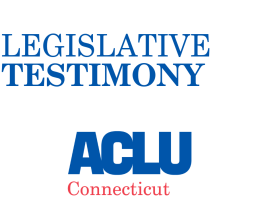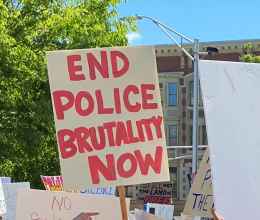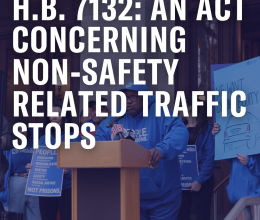
Democracy depends in part on the government being transparent, especially about life and death issues. But right now, there isn’t much transparency when police, who are government employees, kill, hurt, or chase someone. For the most part, police in Connecticut currently control what information the public sees, when we see it, and if we see it at all.
Right now, Connecticut lawmakers are considered a bill that could help to change that.
Police in Connecticut are already required, by law, to fill out something called a “use of force report” every time they use force that could seriously hurt or kill someone. But the law doesn’t require police to share those reports with the state. So, while the information about how many times police hurt or kill people is out there, it’s controlled by police themselves, and it isn’t easily available to the public.
This week, I testified before the Connecticut General Assembly’s Public Safety Committee in support of H.B. 5922, An Act Concerning Use of Force Reports, introduced by Rep. Robyn Porter (Hamden and New Haven). This bill would require police departments to take the simple step of sharing all of their use of force reports, which they are already supposed to be completing, with the state. The state would then be required to analyze and publish information about these reports, giving people in Connecticut, for the first time, solid statewide and town-by-town information about how many times police hurt or kill people, and whether there are racial or geographic disparities in who police hurt or kill. The ACLU of Connecticut is also asking the legislature to strengthen the bill by adding a requirement for police departments to share police pursuit reports with the state, which would include information about every time police decide to chase someone with their vehicles.
It’s terrifying how little information is available when police, who are government employees, hurt or killed people in Connecticut. Based on a recent report from the Danbury News-Times, police have fatally shot at least 24 people in Connecticut since 2013. We have to say “at least,” because, without a state transparency law, no one can know for sure if this number is complete. While state law requires prosecutors to investigate every time police in Connecticut fatally shoot someone, the law doesn’t require similar investigations when police kill someone without a gun, or when police hurt but don’t kill someone. While the state requires police to share reports about every time they use tasers, that law has only been in place since 2015, and it doesn’t apply to other weapons, like guns.
Although people can try to get information through Freedom of Information Act requests, that process is not easy, and police regularly challenge requests for information. When our client’s son, Zoe Dowdell, was shot and killed by police, we had to take legal action to try to get basic information from the New Britain Police Department and Connecticut State Police. More than one year later, Zoe Dowdell’s family is still waiting for the police to send them complete records about what happened to their son. No family should have to go through what the Dowdell family has gone through.
The little information available about police uses of force in Connecticut shows that Black and Latino people are disproportionately being hurt by police in our state. In 2016, 56 percent of people whom police tased or threatened to tase were minorities, an increase in racial disparities from the prior year. Since 2005, based on news reports, at least 18 people died after being tased by police in Connecticut, and 12 were Black or Latino. Everyone in our state, including police, should have a more complete picture of whether these racial disparities are repeated when it comes to things like police firing their guns.
There is also some evidence that police uses of force are getting worse in our state, something that lawmakers, the public, and police would be better able to track if the state collected information about uses of force. In 2017, at least six people – including a three-year-old boy – died in Connecticut after police decided to chase people with their vehicles. According to National Highway Traffic Safety Administration numbers, this was a significant increase from previous years. Some of the people who died were the targets of police pursuits; others were bystanders (pedestrians, or drivers or occupants of other cars). Nationwide, according to a study by USA Today, police car chases killed at least 11,506 people from 1979 and 2013. Nearly 25% of those people (2,456) were bystanders, and more than 130 people who died in police car chases were police themselves.
The use of force reports that this bill would require the state to collect don’t include every piece of information that should be immediately available to the public. They don’t, for instance, include body camera or dashboard camera footage. They are also just one police employee’s interpretation of events – they don’t tell us anything about the perspectives of witnesses, victims, or a police employee’s coworkers. Data alone also won’t establish meaningful accountability for police officers who hurt or kill people.
But the information this bill would require the state to collect and publish is a critical step toward bringing policing – a government job, paid for by taxpayers – out of the shadows and into democracy.




